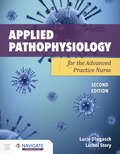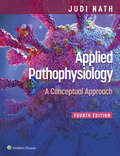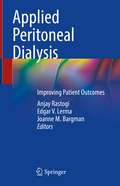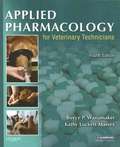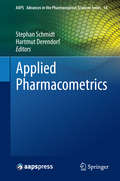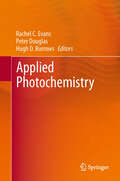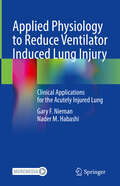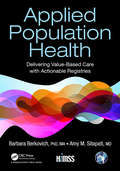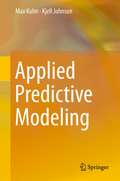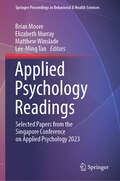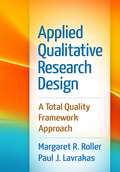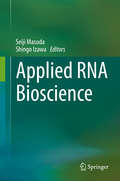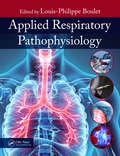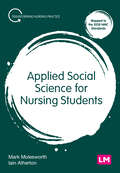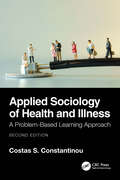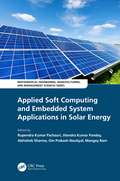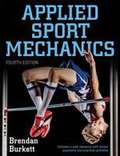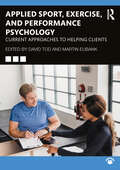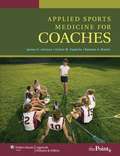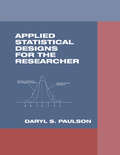- Table View
- List View
Applied Pathophysiology for the Advanced Practice Nurse
by Lachel Story Lucie DlugaschApplied Pathophysiology for the Advanced Practice Nurse, Second Edition is a comprehensive resource that serves as a bridge between clinical experience and the advanced knowledge necessary for the role of an APRN. It helps graduate students navigate the data and presentation of symptoms that must be considered when making a diagnosis and recommendation for treatment. This unique text includes expanded pathophysiology content across the life span and information to meet the needs of many advanced practice population areas, including pediatrics, psychiatric mental health, and gerontology. It also incorporates information from both an acute and primary care focus.
Applied Pathophysiology: A Conceptual Approach
by Carie Braun Judi NathThoroughly updated and informed by the latest research-based evidence, Applied Pathophysiology: A Conceptual Approach, 4th Edition, employs a unique, body function framework to not only deliver the conceptual knowledge students need but also the critical thinking and clinical confidence to effectively apply their understanding to practice. This novel approach instills a deeper understanding of altered human function than traditional memorization, empowering students to achieve optimal client outcomes in the management of a wide range of diseases.
Applied Peritoneal Dialysis: Improving Patient Outcomes
by Edgar V. Lerma Anjay Rastogi Joanne M. BargmanThis book offers a comprehensive guide to peritoneal dialysis (PD). Home dialysis, and more specifically PD, is growing in popularity in the US. By conservative estimates, experts suggest that 45 percent of dialysis patients in the US can be on home dialysis. However, the current penetration rate is only 10 percent. This is changing with an expected major increase in the next 5 years. One of the reasons for the low uptake is that many nephrologists lack comfort and confidence in using PD as a dialysis modality. This book addresses those concerns by covering all aspects of PD. Chapters include its history, patient selection, implementation options, comorbidities, quality of life concerns, and developing approaches to treatment. This comprehensive resource fills the unmet need for a practical, hands-on book that is both detailed and can work as a quick reference. This is an ideal guide for academic nephrologists, private practice nephrologists, NPs, PAs, nurses, fellows, and residents.
Applied Pharmacology for Veterinary Technicians (4th Edition)
by Boyce P. Wanamaker Kathy Lockett MasseyDesigned specifically for veterinary technicians, this essential resource offers detailed guidance on key topics such as managing medication inventory, dispensing veterinarian prescribed drugs, calculating drug dosages, administering medications to animals, and educating clients about drug side effects and precautions. Up-to-date drug information is presented in a consistent, easy-to-use format that includes pharmacokinetics, pharmacodynamics, clinical uses, dosage forms, and adverse side effects. Illustrated, step-by-step procedures demonstrate proper administration techniques for common drug forms. Learning Objectives at the beginning of each chapter help you focus your study efforts and check your progress as you work through the material. Chapter outlines provide at-a-glance overviews of the topics featured in each chapter, making it quick and easy to find information. Key Terms lists with definitions familiarize you with the terminology used in each chapter. Technicians Notes boxes throughout the book provide useful hints and important reminders to help you avoid common errors and increase your efficiency. Coverage of inventory control offers practical tips on performing this important task, including understanding the different vendor types, communicating with sales representatives, and using veterinary practice management computer software. Detailed summaries of important drug laws, such as the Animal Medicinal Drug Use Clarification Act and the Animal Drug Availability Act, introduce you to the legal and ethical aspects of veterinary pharmacology. The companion CD-ROM contains a handy drug dosage calculator and photographs of drug labels to familiarize you with the drug information youll encounter in practice. Proprietary drug names are listed along with generic names to help you learn to recognize drugs with generic options. Additional review questions in this edition help reinforce your understanding of key concepts. Answers are located in the back of the book so you can check the accuracy of your responses. The chapter on Drugs Used in Skin Disorders offers expanded coverage of the anatomy and physiology of the skin, as well as the latest drugs used to treat skin disorders.
Applied Pharmacometrics (AAPS Advances in the Pharmaceutical Sciences Series #14)
by Hartmut Derendorf Stephan SchmidtThis comprehensive volume provides an update on the current state of pharmacometrics in drug development. It consists of nineteen chapters all written by leading scientists from the pharmaceutical industry, regulatory agencies and academia. After an introduction of the basic pharmacokinetic and pharmacodynamic concepts of pharmacometrics in drug development, the book presents numerous examples of specific applications that utilize pharmacometrics with modeling and simulations over a variety of therapeutic areas, including pediatrics, diabetes, obesity, infections, psychiatrics, Alzheimer's disease, and dermatology, among others. The examples illustrate how results from all phases of drug development can be integrated in a more timely and cost-effective process. Applying pharmacometric decision tools during drug development can allow objective, data-based decision making. At the same time, the process can identify redundant or unnecessary experiments as well as some costly clinical trials that can be avoided. In addition to cost saving by expedited development of successful drug candidates, pharmacometrics has an important economic impact in drug product selection. Unsuccessful drug candidates can be identified early and discontinued without expending efforts required for additional studies and allocating limited resources. Hence, pharmacometric modeling and simulation has become a powerful tool to bring new and better medications to the patient at a faster pace and with greater probability of success.
Applied Photochemistry
by Peter Douglas Hugh D. Burrow Rachel C. EvansApplied Photochemistry encompasses the major applications of the chemical effects resulting from light absorption by atoms and molecules in chemistry, physics, medicine and engineering, and contains contributions from specialists in these key areas. Particular emphasis is placed both on how photochemistry contributes to these disciplines and on what the current developments are.The book starts with a general description of the interaction between light and matter, which provides the general background to photochemistry for non-specialists. The following chapters develop the general synthetic and mechanistic aspects of photochemistry as applied to both organic and inorganic materials, together with types of materials which are useful as light absorbers, emitters, sensitisers, etc. for a wide variety of applications. A detailed discussion is presented on the photochemical processes occurring in the Earth's atmosphere, including discussion of important current aspects such as ozone depletion. Two important distinct, but interconnected, applications of photochemistry are in photocatalytic treatment of wastes and in solar energy conversion. Semiconductor photochemistry plays an important role in these and is discussed with reference to both of these areas. Free radicals and reactive oxygen species are of major importance in many chemical, biological and medical applications of photochemistry, and are discussed in depth. The following chapters discuss the relevance of using light in medicine, both with various types of phototherapy and in medical diagnostics. The development of optical sensors and probes is closely related to diagnostics, but is also relevant to many other applications, and is discussed separately. Important aspects of applied photochemistry in electronics and imaging, through processes such as photolithography, are discussed and it is shown how this is allowing the increasing miniaturisation of semiconductor devices for a wide variety of electronics applications and the development of nanometer scale devices. The final two chapters provide the basic ideas necessary to set up a photochemical laboratory and to characterise excited states. This book is aimed at those in science, engineering and medicine who are interested in applying photochemistry in a broad spectrum of areas. Each chapter has the basic theories and methods for its particular applications and directs the reader to the current, important literature in the field, making Applied Photochemistry suitable for both the novice and the experienced photochemist.
Applied Physiology to Reduce Ventilator Induced Lung Injury: Clinical Applications for the Acutely Injured Lung
by Gary F. Nieman Nader M. HabashiThis book details the mechanisms of ventilator induced lung injury (VILI) at the alveolar level with the aim to identify optimal ventilation methods necessary to preserve lung function. Mortality associated with the acute respiratory distress syndrome (ARDS), including that caused by COVID-19, remains unacceptably high. The primary treatment is supportive in the form of protective mechanical ventilation, but set improperly this can cause an unintended secondary VILI significantly increasing mortality. To improve ventilation strategies needed to reduce VILI the alteration in alveolar mechanics caused by ARDS must be understood. The protective ventilation strategy must attempt to normalize alveolar mechanics, which would significantly reduce the mechanical damage subjected to lung tissue during mechanical ventilation. Written by leading experts with numerous diagrams, figures, and videos, this book takes the latest research in the field and translates it to clinical practice. Authors discuss the ARDS-induced alteration in alveolar mechanics that make it so susceptible to VILI and novel ventilation strategies necessary to normalize alveolar mechanics and reduce ARDS related morbidity and mortality. Chapters cover normal lung (alveolar mechanics and micro anatomy), how these are altered during acute lung injury, and the optimal Mechanical Breath Profile (MBp) necessary to stabilize and open the lung to reduce both VILI and acute lung injury-induced morbidity and mortality. This is an ideal guide for pulmonologists, critical care specialists, surgeons, and all medical professionals working with patients on ventilation.
Applied Population Health Approaches for Asian American Communities (Public Health/Vulnerable Populations)
by Chau Trinh-Shevrin Simona C. Kwon Nadia S. Islam Stella S. YiAn insightful text exploring health disparities in Asian American populations In the newly revised Second Edition of Applied Population Health Approaches for Asian American Communities, a team of distinguished public health experts delivers a groundbreaking resource providing an in-depth examination of the soical, political, economic, and cultural forces shaping Asian American health today. Integrating up-to-date applied public health research for assessing health interventions and programs relevant to Asian American communities and other groups that have been historically marginalized, this book highlights the different frameworks, research designs, and other methodological considerations for reaching Asian American and other ethnic communities. In the latest edition of the book, readers will find contextual explorations of the Asian American population in the United States, as well as discussions of the measurement of health and risk across the lifespan in Asian American groups. It also includes: New and updated case studies showcasing the application of different frameworks and research designs Methodological considerations for reaching Asian American and other vulnerable and underserved communities Examples of successful implementations of community engagement and community-based participatory research. A valuable resource for all levels of health professionals, practitioners, and community advocates, Applied Population Health Approaches for Asian American Communities remains the leading reference for anyone conducting or studying health disparities in Asian American communities or other groups that have been marginalized.
Applied Population Health: Delivering Value-Based Care with Actionable Registries (HIMSS Book Series)
by Barbara Berkovich, PhD, MA Amy Sitapati, MDElectronic Health Record (EHR) systems today provide increasing levels of clinical decision support and are the fulcrum for change for value-based healthcare delivery. Billions of dollars of government and insurer payments are dependent on evidence-based workflow design and quality report. In this context, quality measurement is no longer a retrospective exercise, but an essential prospective process embedded in clinical operations. Population health tools in the EHR enhance the efficiency and effectiveness of interventions thus improving the quality of care at lower cost. Population health methods are effective in ensuring that the right patient receives the right care at the right time. This book provides a clear framework for design, implementation, and monitoring of innovative population health tools to accelerate measurable improvements in care delivery. Key benefits for readers include conceptual framework, team approach, and technical insights that result in improved patient care, improved performance on quality measures and increased revenue from quality performance incentives and risk-based contracts. This is also a practice guide to the healthcare professionals many roles who are eager to build or improve population health programs with the goal of delivering high quality value-based care.
Applied Predictive Modeling
by Max Kuhn Kjell JohnsonThis text is intended for a broad audience as both an introduction to predictive models as well as a guide to applying them. Non-mathematical readers will appreciate the intuitive explanations of the techniques while an emphasis on problem-solving with real data across a wide variety of applications will aid practitioners who wish to extend their expertise. Readers should have knowledge of basic statistical ideas, such as correlation and linear regression analysis. While the text is biased against complex equations, a mathematical background is needed for advanced topics. Dr. Kuhn is a Director of Non-Clinical Statistics at Pfizer Global R&D in Groton Connecticut. He has been applying predictive models in the pharmaceutical and diagnostic industries for over 15 years and is the author of a number of R packages. Dr. Johnson has more than a decade of statistical consulting and predictive modeling experience in pharmaceutical research and development. He is a co-founder of Arbor Analytics, a firm specializing in predictive modeling and is a former Director of Statistics at Pfizer Global R&D. His scholarly work centers on the application and development of statistical methodology and learning algorithms.
Applied Psychology Readings: Selected Papers from the Singapore Conference on Applied Psychology 2023 (Springer Proceedings in Behavioral & Health Sciences)
by Brian Moore Lee-Ming Tan Elizabeth Murray Matthew WinsladeThis book is a compilation of the best papers presented at the 2023 edition of the Singapore Conference of Applied Psychology (SCAP), led by East Asia Research in Singapore in collaboration with the Singapore University of Technology and Design and Charles Sturt University in Australia. Chapters include research conducted by experts in the field of applied psychology from the Asia-Pacific region, and cover areas such as the latest innovations, trends, concerns, practical challenges encountered and the solutions adopted in the field of applied psychology such as community and environmental psychology, psychotherapy and counseling, health, child and school psychology, and gender studies. The volume will be of interest to educators, psychology researchers and practicing counselors.
Applied Qualitative Research Design
by Paul J. Lavrakas Margaret R. RollerThis unique text provides a comprehensive framework for creating, managing, and interpreting qualitative research studies that yield valid and useful information. Examples of studies from a wide range of disciplines illustrate the strengths, limitations, and applications of the primary qualitative methods: in-depth interviews, focus group discussions, ethnography, content analysis, and case study and narrative research. Following a consistent format, chapters show students and researchers how to implement each method within a paradigm-neutral and flexible Total Quality Framework (TQF) comprising four interrelated components: Credibility, Analyzability, Transparency, and Usefulness. Unlike other texts that relegate quality issues to one or two chapters, detailed discussions of such crucial topics as construct validity, interresearcher reliability, researcher bias, and verification strategies are featured throughout. The book also addresses applications of the TQF to the writing, review, and evaluation of qualitative research proposals and manuscripts. Pedagogical Features: *Summary tables that highlight important content, such as the application of a method to vulnerable or hard-to-reach populations. *Case studies that illustrate TQF standards in practice for each method. *Guidelines for effective documentation (via thick descriptions) of each type of study. *End-of-chapter discussion topics, exercises, and suggested further reading and Web resources. *Chapters open with a preview and close with a bulleted summary of key ideas. *Extensive glossary.
Applied RNA Bioscience
by Seiji Masuda Shingo IzawaThe focus of this book is to introduce up-to-date information on applications and practical use of RNA for agriculture, biotechnology and medicine.<P><P> It provides unique ideas, tools, and methods in detail from a variety of scientific and technical disciplines. RNA science has progressed enormously in recent decades, and vast amounts of information on RNA functions and their regulatory mechanisms are becoming available. Such a progress opened the door to an age of practical application of RNA in many fields including agriculture, plant science, medical science, brewing and fermentation technology, and material production. <P>This book inspires its readership and contributes to not only expansion in application of RNA but also to basic research.
Applied Radiological Anatomy
by Jeremiah C. Healy Paul Butler Adam W. M. MitchellThis expanded new, full colour edition of the classic Applied Radiological Anatomy is an exhaustive yet practical imaging resource of every organ system using all diagnostic modalities. Every illustration has been replaced, providing the most accurate and up-to-date radiographic scans available. Features of the second edition: * Completely new radiographic images throughout, giving the best possible anatomic examples currently available * Both normal anatomy and normal variants shown * Numerous colour line illustrations of key anatomy to aid interpretation of scans * Concise text and numerous bullet-lists enhance the images and enable quick assimilation of key anatomic features * Every imaging modality included Edited and written by a team of radiologists with a wealth of diagnostic experience and teaching expertise, and lavishly illustrated with over 1,000 completely new, state-of-the-art images, Applied Radiological Anatomy, second edition, is an essential purchase for radiologists at any stage of their career.
Applied Respiratory Pathophysiology
by Louis-Philippe BouletThis easy yet comprehensive reference guide covers the mechanisms of respiratory diseases, explaining the main respiratory conditions for clinicians and postgraduate trainees. It discusses their aetiology as well as the basic concepts required to effectively evaluate and treat them. Applied Respiratory Pathophysiology is the first book to bring together detailed, clinically-relevant explanation of respiratory physiological processes and pathophysiological processes in one text. It is essential reading for anyone diagnosing and treating specific clinical conditions of the lungs.
Applied Social Science for Nursing Students (Transforming Nursing Practice Series)
by Mark Molesworth Iain AthertonWhat are the social sciences and how are they relevant to nursing? How can I apply them to my practice? This book introduces the essential social science that you need in order to register and practice effectively as a nurse. Contributions from the social sciences enable you to better understand the world view of your patients and service users, as well as the wider social, cultural and political landscape in which they live and you provide care. This book will help you apply this knowledge to your everyday practice. Be it providing holistic person-centred care, advocating for your patients and their communities, or contributing to service improvement, understanding the social sciences is key to a nursing career that truly makes a difference. Key features: - Fully mapped to the NMC standards of proficiency for registered nurses (2018) - Explores social science’s contribution to key aspects of your study including sociology, psychology, research, and health promotion - Case studies, activities and student insights illustrate theory and concepts in real life nursing practice
Applied Social Science for Nursing Students (Transforming Nursing Practice Series)
by Mark Molesworth Iain AthertonWhat are the social sciences and how are they relevant to nursing? How can I apply them to my practice? This book introduces the essential social science that you need in order to register and practice effectively as a nurse. Contributions from the social sciences enable you to better understand the world view of your patients and service users, as well as the wider social, cultural and political landscape in which they live and you provide care. This book will help you apply this knowledge to your everyday practice. Be it providing holistic person-centred care, advocating for your patients and their communities, or contributing to service improvement, understanding the social sciences is key to a nursing career that truly makes a difference. Key features: - Fully mapped to the NMC standards of proficiency for registered nurses (2018) - Explores social science’s contribution to key aspects of your study including sociology, psychology, research, and health promotion - Case studies, activities and student insights illustrate theory and concepts in real life nursing practice
Applied Sociology of Health and Illness: A Problem-Based Learning Approach
by Costas S. ConstantinouPraise for the First Edition: "A real, combined approach of behavioural, social, biomedical, and clinical sciences is paramount. [This book] is one pioneering example of such integration, bridging core sociology with medical education." – Dikomitis L, Wenning B, Ghobrial A, and Adams K.M. (2022). Embedding behavioural and social sciences across the medical 2 curriculum: (Auto) ethnographic insights from medical schools in the United Kingdom. Societies, 12, 101. "Constantinou’s book not only contributes to bridging the gap between theoretical sociology and medical education, it also contributes to the way we teach a new generation of students – how to understand patients in context, how to treat them with respect and, ultimately, how to be a better medical doctor." – Andrea Stockl from her Foreword to the First Edition Comments from Medical Students: "‘Ignorance is not just lack of knowledge but lack of implementing knowledge gained’. I encourage everybody going into a clinical and general work setting to read this book and implement." "I believe this book is the key to unlocking the minds of medical students in viewing illness as not only physical and emotional also as social experience." "I believe everyone should read this book, especially medical students and practitioners who wish to become all-round competent and understanding doctors." "The better you understand your patient’s illness and his/her suffering, the healthier you can make him/her – this book teaches this important skill." This popular and accessible text continues to cover the basic principles of the sociology of health and illness in an eminently readable way. This fully revised second edition has been inspired, informed, and reviewed by medical students. By creatively employing a problem-based learning approach, the book examines commonly covered topics integrating underlying principles and research findings through real-life stories. The book investigates the relevance of sociology and considers a new direction – one that places sociology in the context of healthcare settings, making the topic more realistic, useful, and memorable. The book will be an invaluable companion for medical students throughout undergraduate studies and is also a useful reference for students in nursing, social work, psychology, and sociology, as well as qualified doctors and healthcare practitioners.
Applied Soft Computing and Embedded System Applications in Solar Energy (Mathematical Engineering, Manufacturing, and Management Sciences)
by Mangey Ram Jitendra Kumar Pandey Abhishek Sharma Om Prakash Nautiyal Rupendra Kumar PachauriApplied Soft Computing and Embedded System Applications in Solar Energy deals with energy systems and soft computing methods from a wide range of approaches and application perspectives. The authors examine how embedded system applications can deal with the smart monitoring and controlling of stand-alone and grid-connected solar photovoltaic (PV) systems for increased efficiency. Growth in the area of artificial intelligence with embedded system applications has led to a new era in computing, impacting almost all fields of science and engineering. Soft computing methods implemented to energy-related problems regularly face data-driven issues such as problems of optimization, classification, clustering, or prediction. The authors offer real-time implementation of soft computing and embedded system in the area of solar energy to address the issues with microgrid and smart grid projects (both renewable and non-renewable generations), energy management, and power regulation. They also discuss and examine alternative solutions for energy capacity assessment, energy efficiency systems design, as well as other specific smart grid energy system applications. The book is intended for students, professionals, and researchers in electrical and computer engineering fields, working on renewable energy resources, microgrids, and smart grid projects. Examines the integration of hardware with stand-alone PV panels and real-time monitoring of factors affecting the efficiency of the PV panels Offers real-time implementation of soft computing and embedded system in the area of solar energy Discusses how soft computing plays a huge role in the prediction of efficiency of stand-alone and grid-connected solar PV systems Discusses how embedded system applications with smart monitoring can control and enhance the efficiency of stand-alone and grid-connected solar PV systems Explores swarm intelligence techniques for solar PV parameter estimation Dr. Rupendra Kumar Pachauri is Assistant Professor – Selection Grade in the Department of Electrical and Electronics Engineering, University of Petroleum and Energy Studies (UPES), Dehradun, India. Dr. Jitendra Kumar Pandey is Professor & Head of R&D in the University of Petroleum and Energy Studies (UPES), Dehradun, India. Mr. Abhishek Sharma is working as a research scientist in the research and development department (UPES, India). Dr. Om Prakash Nautiyal is working as a scientist in Uttarakhand Science Education & Research Centre (USERC), Department of Information and Science Technology, Govt. of Uttarakhand, Dehradun, India. Prof. Mangey Ram is working as a Research Professor at Graphic Era Deemed to be University, Dehradun, India.
Applied Spatial Data Analysis with R (Use R! #10)
by Virgilio Gómez-Rubio Roger S. Bivand Edzer PebesmaApplied Spatial Data Analysis with R, second edition, is divided into two basic parts, the first presenting R packages, functions, classes and methods for handling spatial data. This part is of interest to users who need to access and visualise spatial data. Data import and export for many file formats for spatial data are covered in detail, as is the interface between R and the open source GRASS GIS and the handling of spatio-temporal data. The second part showcases more specialised kinds of spatial data analysis, including spatial point pattern analysis, interpolation and geostatistics, areal data analysis and disease mapping. The coverage of methods of spatial data analysis ranges from standard techniques to new developments, and the examples used are largely taken from the spatial statistics literature. All the examples can be run using R contributed packages available from the CRAN website, with code and additional data sets from the book's own website. Compared to the first edition, the second edition covers the more systematic approach towards handling spatial data in R, as well as a number of important and widely used CRAN packages that have appeared since the first edition. This book will be of interest to researchers who intend to use R to handle, visualise, and analyse spatial data. It will also be of interest to spatial data analysts who do not use R, but who are interested in practical aspects of implementing software for spatial data analysis. It is a suitable companion book for introductory spatial statistics courses and for applied methods courses in a wide range of subjects using spatial data, including human and physical geography, geographical information science and geoinformatics, the environmental sciences, ecology, public health and disease control, economics, public administration and political science. The book has a website where complete code examples, data sets, and other support material may be found: http://www.asdar-book.org. The authors have taken part in writing and maintaining software for spatial data handling and analysis with R in concert since 2003.
Applied Sport, Exercise, and Performance Psychology: Current Approaches to Helping Clients
by David Tod Martin EubankApplied sport, exercise, and performance psychology practice has diversified considerably over the years, as consultants have explored various theoretical models to guide them in helping their clients. Applied Sport, Exercise, and Performance Psychology: Current Approaches to Helping Clients provides in-depth and critical coverage, from a global perspective, of the common approaches practitioners now use with clients.Chapters are supplemented with case studies showing the approaches in action. The text explores topics such as: Cognitive behavioural approaches Psychodynamics approaches Family systems therapy approaches Mindfulness approaches Practitioner training and development Cultural considerations in practice Evidence-based practice This text is a vital resource for students in applied sport psychology courses, sport and exercise science courses, and psychology and counselling courses. It is also an invaluable read for practicing applied sport, exercise, and performance psychologists, as well as coachesand parents with some background in psychology.
Applied Sports Medicine for Coaches
by James Johnson Esther Haskvitz Barbara BrehmWritten for coaches, this textbook explains what you need to know about sports medicine in order to integrate optimal performance training with an injury prevention program. Moreover, it helps you communicate effectively with health professionals and better understand the nature of an injury, its treatment, the injured athlete's limits, and his or her rehabilitation needs.
Applied Statistical Considerations for Clinical Researchers
by David CullifordThis essential book details intermediate-level statistical methods and frameworks for the clinician and medical researcher with an elementary grasp of health statistics and focuses on selecting the appropriate statistical method for many scenarios. Detailed evaluation of various methodologies familiarizes readers with the available techniques and equips them with the tools to select the best from a range of options. The inclusion of a hypothetical case study between a clinician and statistician charting the conception of the research idea through to results dissemination enables the reader to understand how to apply the concepts covered into their day-to-day clinical practice.Applied Statistical Considerations for Clinical Researchers focuses on how clinicians can approach statistical issues when confronted with a medical research problem by considering the data structure, how this relates to their study's aims and any potential knock-on effects relating to the evidence required to make correct clinical decisions. It covers the application of intermediate-level techniques in health statistics making it an ideal resource for the clinician seeking an up-to-date resource on the topic.
Applied Statistical Designs for the Researcher (Chapman & Hall/CRC Biostatistics Series)
by Daryl S. PaulsonShowcasing a discussion of the experimental process and a review of basic statistics, this volume provides methodologies to identify general data distribution, skewness, and outliers. It features a unique classification of the nonparametric analogs of their parametric counterparts according to the strength of the collected data. Applied Statistical Designs for the Researcher discusses three varieties of the Student t test, including a comparison of two different groups with different variances; two groups with the same variance; and a matched, paired group. It introduces the analysis of variance and Latin Square designs and presents screening approaches to comparing two factors and their interactions.
